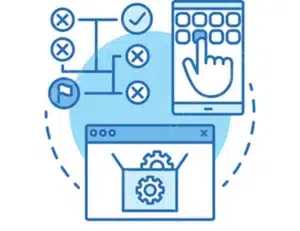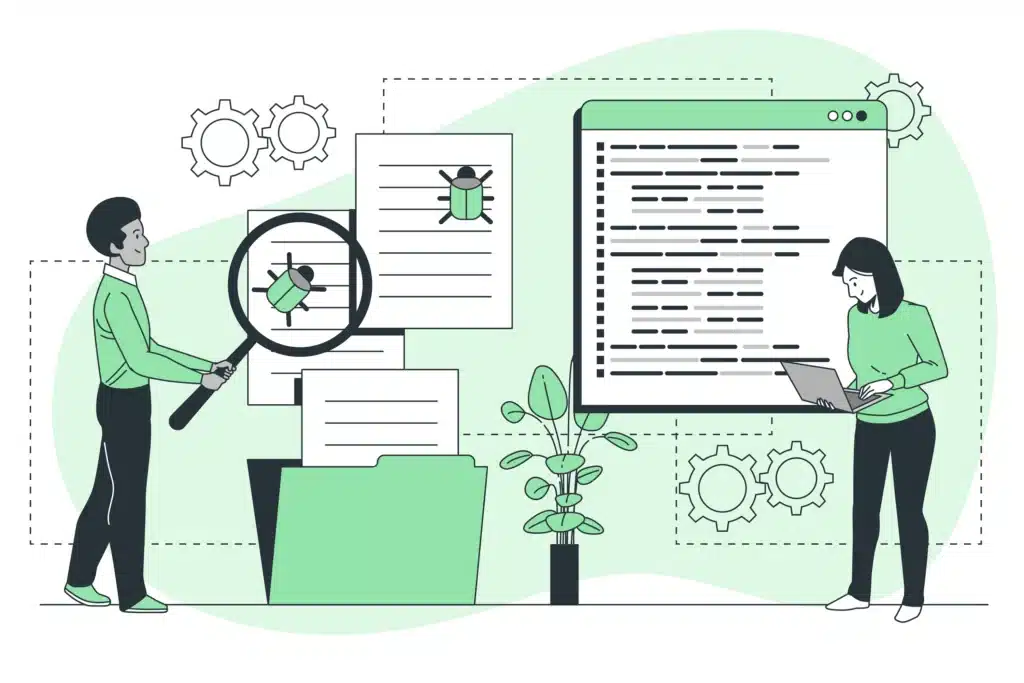Table of Contents
WHAT IS USABILITY TESTING
Usability refers to how easily and efficiently users can interact with a system, and during usability testing, factors such as ease of use, efficiency, user satisfaction, and error rates are measured.
Usability refers to the degree to which a product or system can be used by specified users to achieve specified goals effectively, efficiently, and satisfactorily in a given context of use.

WHAT TO MEASURE DURING USABILITY TESTING
During usability testing, the following key factors are typically measured:
Effectiveness: How well users can complete tasks correctly using the system (e.g., task success rate).
Example scenario: Online Banking System
Task: Transfer money from your savings account to your checking account.
Success Metric: The user successfully completes the task by transferring money without any errors or assistance.
Assessment: The system allows the user to select the correct accounts, input the right amount, and submit the transfer without encountering errors. A high success rate would indicate that users can complete the task correctly with ease.
Efficiency: The time or resources required for users to complete tasks (e.g., task completion time).
Example scenario: Online Shopping Website
Task: Find and purchase a specific item (e.g., a laptop).
Success Metric: The time it takes for the user to find the laptop, add it to the cart, and complete the checkout process.
Assessment: The user starts by searching for the laptop, navigates through product options, adds it to the cart, and completes payment. Measuring the time taken from the start of the search to the completion of the checkout will help assess the efficiency of the website. A shorter task completion time indicates a more user-friendly system, while a longer time may suggest issues like complex navigation or unclear information.
Satisfaction: The users’ overall satisfaction and comfort while using the system, often measured through surveys or feedback.
Example scenario: Food Delivery App
Task: Order a meal from a restaurant.
Success Metric: After the user completes their meal order, they are prompted to rate their experience on a scale of 1 to 5 and provide optional feedback.
Assessment: The user is asked questions like:
How easy was it to navigate the app? (1-5 scale)
How satisfied are you with the food delivery time? (1-5 scale)
How would you rate the overall experience? (1-5 scale)
Any suggestions for improvement? (open-ended)
Users’ ratings and comments provide insights into their comfort and satisfaction levels. High ratings and positive feedback would indicate good user satisfaction, while lower ratings or negative feedback might highlight areas for improvement.
Learnability: How easy it is for users to learn and become proficient with the system during the initial use.
Example scenario: New Photo Editing Software
Task: Edit a photo (crop, apply a filter, and adjust brightness).
Success Metric: After the user launches the software for the first time, they are asked to perform basic tasks (like cropping a photo, applying a filter, and adjusting brightness).
Assessment:
Users are observed during their first session as they navigate the interface.
The time it takes them to complete the task is recorded.
Afterwards, users are asked:
How easy was it to learn how to use the software? (1-5 scale)
Did you find the interface intuitive? (Yes/No)
Were there any features that confused you? (Open-ended)
If users can quickly and correctly complete the task with minimal guidance, and provide positive feedback on ease of use, it would indicate that the system is easy to learn and users become proficient during the initial use.
Error Rate: The frequency and types of errors users encounter during interaction, including how they recover from errors.
Example scenario: Online Booking System for Flights
Task: Book a round-trip flight
Success Metric: During the booking process, the user interacts with the system to select flight dates, destinations, and personal details.
Assessment:
Error Tracking: Track how often users encounter errors (e.g., selecting incorrect dates, entering invalid payment details).
Types of Errors: Common errors might include selecting a non-existent date, entering an invalid email, or exceeding the payment limit.
Error Recovery: Observe how users recover from these errors:
Does the system display clear error messages (e.g., “Please enter a valid email address”)?
Does the user immediately understand how to fix the error without external help?
After completing the task, users are asked:
Did you encounter any issues during booking? (Yes/No)
If yes, how easy was it to fix the problem? (1-5 scale)
Was the error message helpful? (Yes/No)
If users frequently encounter errors but can quickly recover from them due to helpful error messages or easy-to-follow instructions, this indicates a system that is functional but may need some improvements for better user experience. Frequent or confusing errors that prevent users from completing tasks would highlight areas for improvement.
Memorability: How easily users can remember how to use the system after not using it for a period of time.
Example scenario: Recipe Mobile App
Task: After not using the app for a few weeks, the user is asked to find and follow a recipe for dinner.
Success Metric: The user reopens the app and attempts to navigate to a recipe without any guidance or instructions.
Assessment:
Time Taken: Measure how long it takes the user to find and start following a recipe.
Error Rate: Track any errors made (e.g., selecting the wrong recipe, difficulty navigating the app).
Feedback: After completing the task, the user is asked:
How easy was it to remember how to use the app after not using it for a while? (1-5 scale)
Did you need to refer to the help section or instructions? (Yes/No)
Were you able to find and follow a recipe without difficulty? (Yes/No)
If users can quickly and correctly navigate the app without needing reminders or help, it suggests that the system is easy to remember and use after a break. Conversely, if users struggle to remember how to use the app, this might indicate a need for improved design or more intuitive features.
Takeaway: The key factor here is the app’s usability. A well-designed system with clear labels, helpful reminders, and consistent layout allows users to easily recall how to use it after a period of inactivity.
User Engagement: The level of user interest, involvement, and enjoyment during the interaction.
Example Scenario: A Mobile Fitness App
Imagine you’re using a mobile fitness app to track your workouts and progress. Here’s how different levels of user interest, involvement, and enjoyment might play out:
High Interest, Involvement, and Enjoyment:
You open the app to start a new workout session. The app personalizes the experience based on your goals (e.g., weight loss or muscle gain). It offers a fun and interactive workout routine with engaging visuals and motivating music. During the workout, it provides real-time feedback and encourages you to push harder, celebrating your progress with badges and rewards. You find yourself looking forward to each workout because the app makes it enjoyable and feels like a part of your fitness journey.
Low Interest, Involvement, and Enjoyment:
You open the app, but it feels generic and doesn’t offer any personalizations. The workout is just a list of exercises with minimal explanation, and the app doesn’t interact with you during the session. The interface is clunky, and there are no fun elements like achievements or progress tracking. You finish the workout but feel indifferent—there’s little motivation to use the app regularly or engage with it further.
Takeaway: The level of interest, involvement, and enjoyment is influenced by how engaging, motivating, and interactive the system is. When an app provides personalized content, rewards, and fun elements, users are more likely to feel interested and enjoy using it.
These metrics help evaluate and improve the user experience by identifying pain points and areas for enhancement.
IMPORTANCE OF USABILITY TESTING
Usability testing is crucial because it helps ensure that a product or system meets user needs and expectations, leading to a better user experience. The importance of usability testing includes:
Enhances User Experience: By identifying usability issues, it helps optimize interfaces, workflows, and interactions to make them more intuitive and
user-friendly.Example scenario: Online Shopping Website
Imagine you’re part of a team developing an online shopping website. Before launching it, you conduct usability testing to see how real users interact with the site.
Usability Testing Process:
Test Participant: Kiran, a regular online shopper, is asked to complete a task on the website, such as finding a specific product, adding it to the cart, and checking out.
Observation: During testing, Kiran struggles to find the “search bar” because it’s placed too far down on the page. He also finds the checkout process confusing due to unclear buttons and multiple
steps.Feedback: Kiran mentions that the website feels overwhelming because there are too many options displayed at once. He suggests a clearer navigation system and simpler checkout process.
Changes: The development team redesigns the website based on Kiran’s feedback:
Moves the search bar to a more prominent location
Simplifies the checkout process into fewer steps
Reduces the number of items shown at once to avoid overwhelming users
Retest: After these changes, another round of usability testing is conducted with a new participant. This time, the process is smoother, and the participant finds it much easier to navigate.
Outcome: After incorporating the insights from usability testing, the website becomes much easier to use. Users like Kiran can quickly find what they need, enjoy a simplified checkout process, and have a much more satisfying experience.
Takeaway: Usability testing directly enhances the user experience by identifying pain points, gathering feedback, and making improvements to make the system more intuitive and enjoyable to use.
Improves Efficiency: It identifies and removes obstacles that hinder task completion, allowing users to perform tasks more quickly and effectively.
Example scenario: A Task Management App
Imagine you are part of a team designing a task management app. You want to make sure that users can complete tasks quickly and efficiently, so you conduct usability testing to identify areas for improvement.
Usability Testing Process:
Test Participant: Kiran, a user who frequently manages projects, is asked to complete a task: creating a new project, adding tasks, and setting deadlines.
Observation: During testing, Kiran struggles to find the “add task” button because it’s hidden under a submenu. He also takes longer than expected to set deadlines because the date picker is confusing and not easy to navigate.
Feedback: Kiran comments that the app would be much faster if the “add task” button were more visible, and the date picker should be simplified.
Changes: The development team makes the following adjustments based on Kiran’s feedback:
Moves the “add task” button to the main screen for easy access.
Simplifies the date picker by providing a calendar view and eliminating unnecessary steps.
Retest: After the changes, another round of testing is conducted. This time, Kiran is able to complete the same tasks much faster and more efficiently.
Outcome: After incorporating these changes, users can now complete their tasks in less time. The app is more streamlined, and the process of managing projects is faster and less frustrating.
Takeaway: Usability testing improves efficiency by identifying areas where users waste time or face difficulties. By making these areas more intuitive or quicker to navigate, users can complete tasks faster, increasing the overall efficiency of the system.
Reduces Errors: Usability testing highlights areas where users may make mistakes or struggle, helping to design interfaces that minimize errors and improve accuracy.
Example scenario: A Flight Booking Website
Imagine you’re part of a team developing a flight booking website. You conduct usability testing to ensure that users can easily book flights without making errors.
Usability Testing Process:
Test Participant: Lisa, a frequent traveler, is asked to book a round-trip flight from New York to Los Angeles for an upcoming vacation.
Observation: During testing, Lisa accidentally selects the wrong return date because the calendar interface isn’t clearly marked with the current date, and the dates are close together. She also selects the wrong flight class due to a confusing layout that makes it hard to differentiate between economy, business, and first-class options.
Feedback: Lisa points out that the date picker should highlight the current date more clearly, and the flight class options should be more distinguishable to prevent confusion.
Changes: The development team makes the following improvements based on Lisa’s feedback:
Adds a bold highlight for the current date to make it stand out in the calendar.
Reorganizes the flight class options with clearer labels and icons for each category, and adjusts the layout for better distinction.
Retest: After the changes, another round of usability testing is conducted. This time, Lisa successfully selects the correct return date and flight class without any mistakes.
Outcome: After these changes, users are less likely to make errors when booking flights. The interface is clearer, and the process becomes more intuitive, reducing the chances of incorrect selections.
Takeaway: Usability testing helps reduce errors by identifying confusing or unclear aspects of the interface. By fixing these areas, users are less likely to make mistakes, improving their overall experience and the accuracy of their interactions with the system.
Increases User Satisfaction: By ensuring the system is easy to use and meets user expectations, usability testing boosts overall satisfaction, leading to positive feedback and loyalty.
Scenario: A Food Delivery App
Imagine you’re part of a team developing a food delivery app. You conduct usability testing to ensure the app is easy and enjoyable to use, aiming to increase user satisfaction.
Usability Testing Process:
Test Participant: Mark, a busy professional, is asked to order lunch through the app.
Observation: During testing, Mark gets frustrated because the app takes too long to load, and the restaurant search function is difficult to use. The filters to narrow down restaurant options aren’t intuitive, and it takes him several attempts to find a place that delivers to his location.
Feedback: Mark mentions that he would feel more satisfied with the app if the restaurant search was faster and the filtering options were clearer. He also suggests adding a “favorites” feature so he can easily reorder from restaurants he likes.
Changes: Based on Mark’s feedback, the development team makes improvements:
Speeds up the restaurant search functionality and enhances the filter system to make it more intuitive.
Adds a “favorites” feature for quicker reordering.
Improves the app’s loading speed to make it more responsive.
Retest: After the changes, another round of usability testing is conducted. This time, Mark quickly finds a restaurant, applies the filters easily, and places his order within a few minutes.
Outcome: After these improvements, Mark has a smoother and more satisfying experience. He is able to order quickly, and the app feels more efficient and user-friendly.
Takeaway: Usability testing increases user satisfaction by identifying pain points that cause frustration and improving them. By addressing these issues, the system becomes easier and more enjoyable to use, leading to happier users.
Saves Time and Costs: Identifying usability issues early in the development process prevents costly revisions later. It also ensures that users can adopt the system quickly, minimizing training and support costs.
Scenario: A team is developing a new e-commerce website and tests the checkout process with a few users. During testing, users get confused by a confusing coupon code field, which leads them to abandon their purchases before completing the transaction.
Takeaway: The team realizes that the coupon code field is not clearly labeled, and many users don’t notice it until after entering payment information, creating unnecessary frustration.
Outcome: By fixing the labeling and placement of the coupon code field before launch, the company saves time by avoiding costly post-launch fixes and customer support inquiries. This results in more completed transactions, higher sales, and fewer resources spent on handling complaints.
Boosts Product Adoption: A product with a user-friendly interface is more likely to be adopted by its target audience, especially if it is intuitive and aligns with user needs.
Scenario: A startup releases a new fitness app and conducts usability testing with several users. During testing, users struggle to find the daily workout plan because it’s buried in a sub-menu, causing frustration and confusion.
Takeaway: The team realizes that key features, like the daily workout plan, need to be more easily accessible and clearly visible from the home screen to enhance the user experience.
Outcome: After simplifying the navigation and making the workout plan more prominent, users find the app easier to use. As a result, the app sees an increase in daily active users and higher retention rates, boosting product adoption and user satisfaction.
Supports Business Goals: Usability testing can directly influence business metrics, such as conversion rates, customer retention, and customer lifetime value, by improving the ease and effectiveness of user interactions.
Scenario: A retail company launches a new mobile app but notices a high rate of cart abandonment during the checkout process. Usability testing reveals that users find the payment options unclear and difficult to navigate, leading them to abandon their purchases.
Takeaway: The team discovers that simplifying and clearly labeling payment optionscould significantly improve the checkout process and reduce friction for users.
Outcome: After making adjustments to improve payment clarity and streamline the process, the app sees a decrease in cart abandonment and a rise in completed transactions. This directly supports the company’s goal of increasing sales and improving customer experience, driving overall business growth.
CONCLUSION

Overall, usability testing ensures that the product is not only functional but also efficient, engaging, and aligned with users’ goals, which ultimately drives product success.


